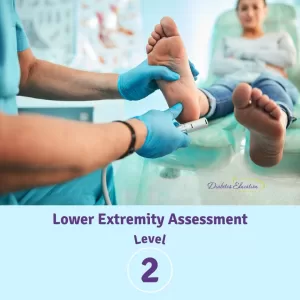
Which of the following best describes the proper technique for using a 10-gram monofilament to assess protective sensation in a person with diabetes?
- Press the monofilament firmly against the skin until it bows for at least 2 seconds, then ask if the person if they feel pressure.
- Stroke the monofilament across the skin surface to assess for light touch sensation.
- Apply the monofilament to the dorsal surface on random sites without informing the individual when contact is made.
- Press the monofilament until it bends into a “C” shape at selected sites, holding for about 1 second before lifting.
Want to learn more about this question and get ready for certification exam success?
Join us live on April 29th for our
Lower Extremity Assessment
Level 2

Can’t make it live? Don’t worry – you have access to the recorded version for a year after purchase!
People with diabetes are at increased risk of Lower Extremity Complications. This course reviews the steps involved in performing a detailed assessment of the lower extremities, including how to use a monofilament and tuning fork to detect neuropathy. We also discuss the significance of the Ankle Brachial Index and strategies to prevent lower extremity complications.
All hours earned count toward your CDCES Accreditation Information
Sign up for Diabetes Blog Bytes – we post weekly Blog Bytes that are informative and FREE! Every week we post one exam practice Question of the Week and Rationale of the Week. Sign up below!
Recent Blog Bytes
The use of DES products does not guarantee the successful passage of the certification exam. CBDCE and ADCES do not endorse any preparatory or review materials for the CDCES or BC-ADM exams, except for those published by CBDCE & ADCES.









